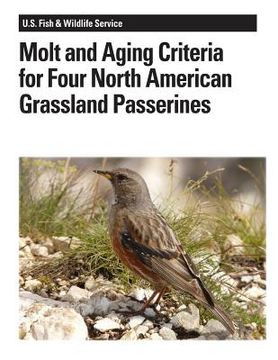Reseña del libro "Molt and Aging Criteria for Four North American Grassland Passerines (en Inglés)"
Prairie and grassland habitats in central and western North America have declined substantially since settlement by Europeans (Knopf 1994) and many of the birds and other organisms that inhabit North American grasslands have experienced steep declines (Peterjohn and Sauer 1999; Johnson and Igl 1997; Sauer, Hines, and Fallon 2007). The species addressed here, Sprague's Pipit (Anthus spragueii), Grasshopper (Ammodramus savannarum) and Baird's (A. bairdii) sparrows, and Chestnut-collared Longspurs (Calcarius ornatus), are grassland birds that are of special conservation concern throughout their ranges due to declining populations and the loss of the specific grassland habitats required on both their breeding and wintering ranges (Knopf 1994, Davis and Sealy 1998, Davis 2003, Davis 2004, Jones and Dieni 2007). Population-trend data on grassland birds, while clearly showing declines, provides no information on the causes of population declines. Without demographic information (i.e., productivity and survivorship), there are no means to determine when in their life cycle the problems that are creating these declines are occurring, or to determine to what extent population trends are driven by factors that affect birth rates, death rates, or both (DeSante 1995). For migratory birds, population declines may be driven by factors on breeding grounds, during migration, and/or on wintering grounds. Lack of data on productivity and survivorship thus impedes the formulation of effective management and conservation strategies to reverse population declines (DeSante 1992). Furthermore, if deficiencies in survivorship are revealed, management strategies may need to address habitats on both breeding and non-breeding grounds, as well as along migratory pathways. One technique that helps inform management strategies is the biochemical analysis of isotopes and genetic markers, from the sampling of individual feathers from live birds (Smith et al. 2003, Pérez and Hobson 2006; Appendix). Determining demographic parameters and effectively sampling feathers to reveal connectivity between breeding and wintering grounds requires detailed knowledge of molt patterns and age determination criteria for the target species, in the hand. For example, productivity, survivorship, and territory acquisition may all be age-dependent, with first-year birds showing different patterns and responses than older birds. In many cases it may be possible to sample both a feather grown on the breeding grounds and one grown on the wintering grounds from a single individual, but knowledge of age-specific molt patterns, as well as an ability to recognize different feather generations, is needed to accomplish such a task. While some information on molt and aging criteria exists for grassland passerine species (Pyle 1997a), these species have been rarely captured during mark-recapture studies (Jones et al. 2007) and this information thus needs refining. There is a need for additional resources to assist field workers in determining molt patterns and age in captured individuals. Our objective is to describe molt and aging criteria for four grassland passerine species with the aid of digital photographs taken in the field. We hope that this document will be useful for researchers studying grassland species through capture and banding of live individuals on either the breeding or the wintering grounds. We present a general section on molt and aging techniques, followed by specific accounts for the four species treated: Sprague's Pipits, Grasshopper and Baird sparrows, and Chestnut-collared Longspur. We also provide a brief protocol on collecting feather samples (Appendix).

